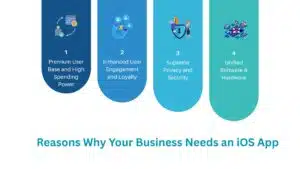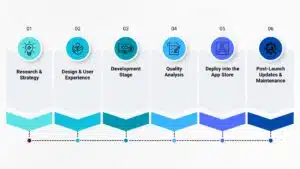Today, the perfect ingredient to thrive in your business is to meet your customers where they spend most of their time. The iOS devices are now more common among users, and today, creating a business-specific app for the Apple ecosystem is more of a necessity than an option.
To give you a perspective, there are more than 1 billion active users using iOS apps all across the globe. So, seeking iOS mobile app development isn’t just about adhering to any trend, but is a crucial demand for your business to connect with valuable customers.
Irrespective of whether you are a startup owner or an established enterprise, this guide will help you learn how you can develop an iOS app, making it the face of your business, and drive success in a competitive industry.
Understanding iOS App Development
The process of creating dedicated mobile applications that can run on Apple devices like iPads and iPhones is referred to as iOS app development. Such applications are built with the use of specific coding languages like Objective-C and Swift, followed by certain strict performance & design guidelines, as set by Apple itself.
The entire iOS ecosystem is widely popular among users and businesses for its consistent user experience, extensive functionalities, and robust security. Features like the iphone esim also highlight Apple’s focus on seamless integration and convenience, and developers must keep such innovations in mind when designing apps that enhance user value. When you build an app for iOS devices, it means you are creating an application that can sync and function well alongside Apple’s software and hardware.
For instance, Apple’s iOS devices come with special features such as Apple Pay, Siri, Face ID, and more such capabilities, and your app must complement them for a better user experience. If your users appreciate good design and flawless performance, developing an iOS app can be a game-changing move for your business.
Types of iOS App Development You Can Adopt
Before you know how to develop an app for iPhone and iPad devices, it is better to understand the available types you can opt for. Depending on your budget, target audience, and goals, you can either opt for a native iOS or a hybrid app:
-
Native iOS Apps:
As the name suggests, the native iOS apps are built specifically for Apple devices, using the company’s proprietary coding languages and development tools. Developers make use of Objective-C or Swift, alongside tools such as Xcode for building native iOS apps. Such apps are built and deployed to leverage the full potential of an Apple device’s software & hardware capabilities.
-
Hybrid or Cross-Platform Apps:
Hybrid apps are built using JavaScript, CSS, and HTML, with the purpose of running seamlessly on both Android and iOS devices. Such applications are built using frameworks like React Native, Flutter, and .NET MAUI. Developers have the liberty to write only a single unified codebase while deploying the app across both Android and iOS platforms.
-
Low-Code Platform
You can also seek iOS apps built using low-code platforms, facilitating minimal coding and faster deployment. Such apps are built using visual interfaces, pre-built components, and drag-and-drop functionality. It is a cost-effective and faster alternative to other types of iOS apps, fostering better integration capabilities, enhanced collaboration, and increased agility.
Reasons Why Your Business Needs an iOS App
Here are a few reasons why your business shouldn’t have second thoughts about getting an iOS mobile app:
Among all smartphone users, iOS device owners are considered part of the affluent demographic. It means that such users are presumed to have higher average incomes, and data proves it! There is a higher chance that Apple device owners will spend more on premium apps or in-app purchases, giving your business a good earning chance.
2. Enhanced User Engagement and Loyalty
Apple has a very strong reputation in the global smartphone market and has built a loyal customer base. People who trust iOS devices are deeply integrated within the Apple ecosystem, ensuring frequent usage and higher retention rates. Such users tend to trust an iOS app without much of a second thought, giving you a better growth potential.
3. Supreme Privacy and Security
Apple puts up strict App Store review guidelines, alongside several built-in features, prioritizing user privacy and security, which attracts more people to trust iOS devices and the supported apps. Features such as ‘App Tracking Transparency’ support enhanced data protection. Following that, such strict checks help build trust between an app and its users.
4. Unified Software & Hardware
When compared to other platforms, Apple has fewer device models, making it easier for you to test & fine-tune the iOS apps for better performance. As a result, you can drive a consistent experience of your app for users across iPads as well as iPhones.
Step-by-Step Approach on How to Develop an iOS App
Building a high-performance iOS app for business isn’t just about writing the code. Instead, it is a full-fledged journey that demands stakeholders to be active participants in the process. A successful app needs your agility, deep understanding of users, and continuous foresight. Therefore, here are some of the essential steps that you must take for developing applications for iPhone and iPad devices:
1. Research and Strategy
Before your developers start writing the first line of code, you must prioritize defining the core purpose of the app you are willing to build. Derive the features or functionalities that you think will make it stand out! And for that, you need to do a thorough market research and understand the needs of your target audience.
Determine the pain points of users that your application can solve, and outline specific features for the MVP (Minimum Viable Product). In this step, your goal should be to ensure your iOS mobile app development project is approached towards solving a real problem while adhering to the overall business goals.
2. Design & User Experience
It is now time to give your vision a shape, both interactively and visually! The team of designers will now take over your iOS mobile application development project and commence with the wireframing stage. Here, your team will create digital sketches of all the concepts derived from the last stage, representing how the app would look.
Following that, the UI/UX experts will craft an intuitive appeal for the iOS app, making it not just visually aesthetic but also easy to use. Before moving forward with the development stage, the design professionals will be curating the software architecture of the app, comprising the MVC (Model View Controller) paradigm. It will ensure the stability and scalability of the application moving forward!
3. Development Stage
With the design parameters in place, the development stage can now commence! Here, the developers will build the iOS app in three parts: backend, APIs, and frontend. While approaching backend development, experts will curate the server-side logic, dedicated systems, and databases that will power the functionality of your application.
Under the frontend development stage, the UI of your app will be designed and coded, ensuring an engaging experience for the users. Finally, the API integrations will be done to connect your app to various external databases or services, guaranteeing seamless data exchange.
4. Quality Analysis
Before your iOS app goes for an App Store Review, it should be tested thoroughly, considering Apple’s strict guidelines on performance and security. From unit and integration tests to performance and user acceptance tests, all the test cases must be executed by your QA team, backed by the necessary tools.
The goal of this step is clear: all the potential bugs of your iOS app must be fixed, while the performance must be optimized. Following that, this stage will also ensure that your app is reliable, secure, and all set to be used by your target audience.
5. Deploy into Apple’s App Store
Submitting your iOS app to the App Store is a crucial phase, and you need to ensure it meets all the approval guidelines of the tech giant. From features and functionalities to security and design, everything should align with Apple’s approval policies.
You might have to do some final checks or adjustments to your application, ensuring a smooth launch. Once your app justifies Apple’s standards for user experience and quality, it will be successfully deployed.
6. Post-Launch Updates and Maintenance
Developing and deploying an iOS app isn’t a one-time task! You ought to ensure that it stays functional, competitive, and secure in the long run. Therefore, post-launch maintenance and timely updates are essential.
In this stage, you will be looking after fixing bugs, adding new features, prioritizing updates, and more, based on growing market trends or user feedback. This way, your application will stay consistent in terms of performance while adhering to users’ expectations.
How Can Simpalm Help You with iOS App Development?
From initial ideation and development to deployment and maintenance, Simpalm extends its decades of experience in iOS mobile app development services. We have dedicated developers proficient in using Swift, Objective-C, XCode, SwiftUI, and other such iOS tools for curating the perfect mobile applications.
At Simpalm, we help you plan the design, features, or functionalities that should be part of your iOS app. Our team will not just be ensuring optimal performance out of your mobile application, but will also make sure it aligns with Apple’s strict App Store guidelines.
Irrespective of whether you want to create a native iOS app or a hybrid version, Simpalm has the right tools and expertise to help meet your requests. Let us help you expand your business outreach to iOS users with our proficient app development solutions.
Conclusion
Seeking iOS mobile application development might be overwhelming as it demands an agile yet efficient approach, inclusive of multiple stages. You need utmost technical supremacy to achieve proficiency with every stage, guaranteeing top-notch performance for your iOS app. From ideation and design to deployment and maintenance, every stage counts.
So, it’s always better to partner with the best iOS app development company and let the experts make your vision a reality! Get in touch with our experts

 App Development
App Development Web Engineering
Web Engineering AI Services
AI Services Startups
Startups Health / Fitness
Health / Fitness Education
Education Social
Social Nonprofit
Nonprofit Fintech
Fintech Logistics
Logistics Government
Government HR Software
HR Software About Simpalm
About Simpalm Our News
Our News Client Testimonials
Client Testimonials Careers
Careers Awards
Awards Resources
Resources Information
Information







